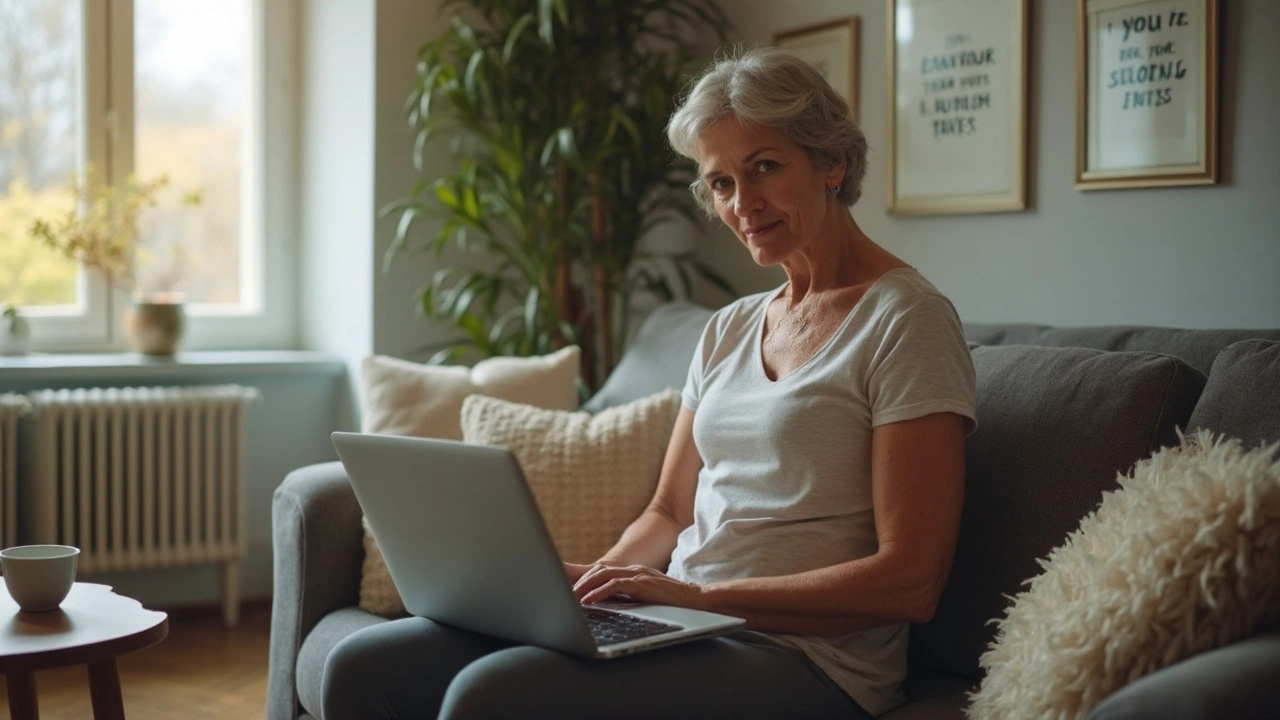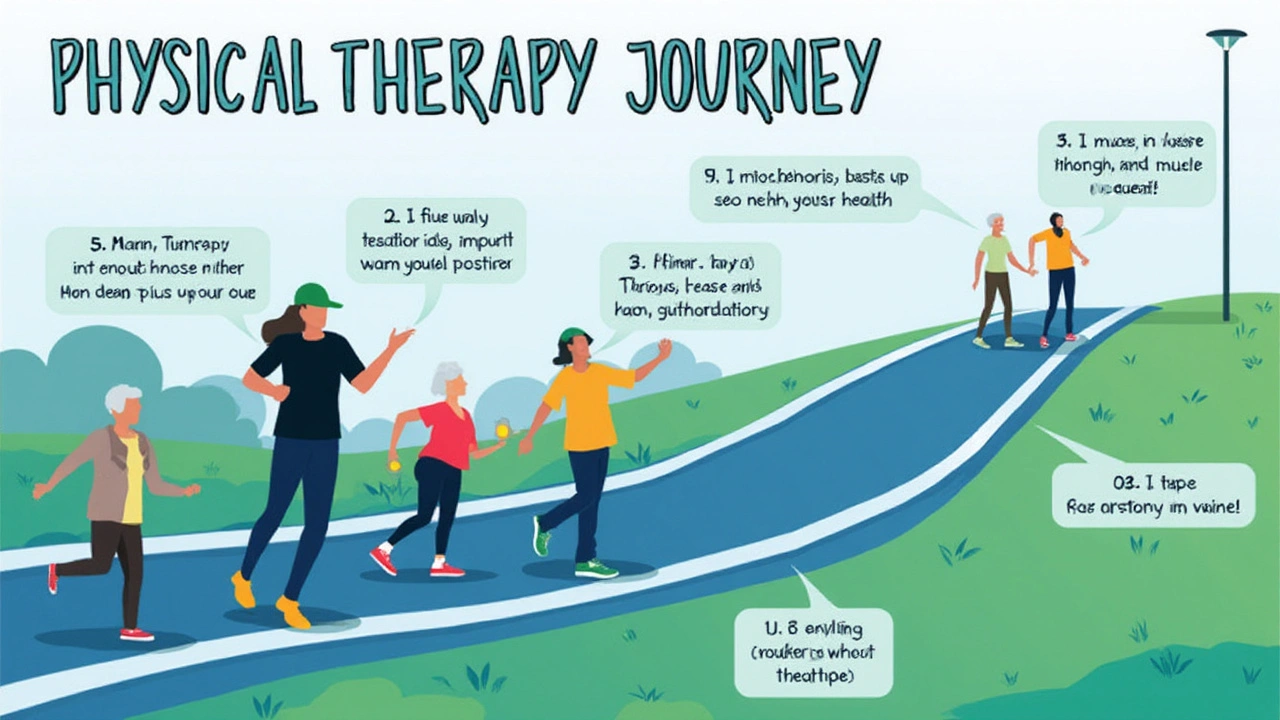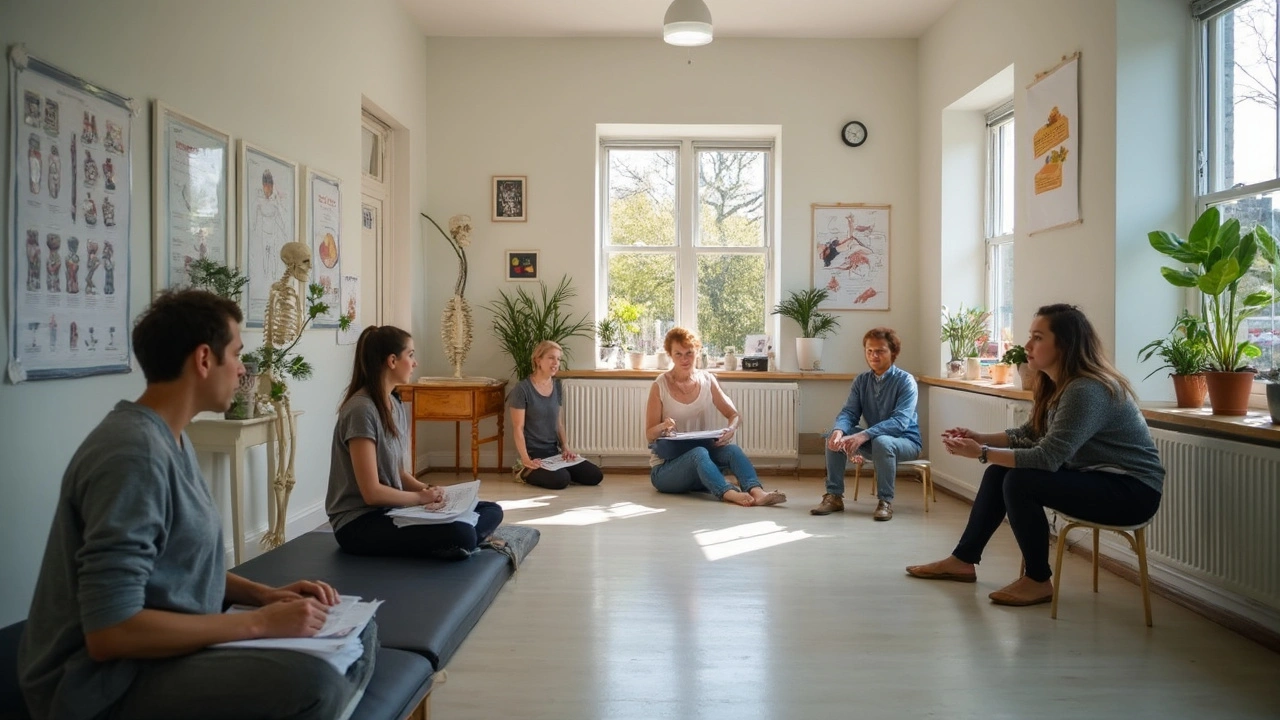Ever tweaked your back picking up groceries, or pulled a muscle just bending the wrong way? It happens to almost everyone at some point, and it doesn’t just happen to athletes. Muscle strains, sprains, and overuse injuries are ridiculously common. Here’s the thing: resting too much or just hoping the pain will disappear can actually make things worse. That’s where physical therapy steps in.
Physical therapists don’t just hand you a list of exercises and send you on your way. They dive into how you move, what really triggered your injury, and what needs fixing—not just on the surface, but deep down in your muscle function. With the right therapy, you can speed up healing, cut down on pain, and get back to your normal routine faster. If you’re tired of limping or can’t even tie your shoes without a twinge, physical therapy isn’t just another option—it’s one of the most effective routes out there.
- Why Skeletal Muscle Conditions Hold You Back
- How Physical Therapy Builds Strength and Mobility
- What Happens During a Typical Physical Therapy Session
- Tips to Maximize Your Recovery Results
- Preventing Future Muscle Problems
Why Skeletal Muscle Conditions Hold You Back
Your skeletal muscle system is the backbone of everything you do—literally. These muscles let you walk, lift, run, and even sit up straight. When something goes wrong, like a strain or muscle tear, it isn’t just a little ache. It can mess with simple stuff, like climbing stairs or playing with your dog.
According to the CDC, muscle injuries keep millions of people away from work and regular activities every year. That’s not just sidelining athletes. Office workers, parents, and even students aren’t immune. Some muscle conditions, like strains or sprains, can heal up okay on their own. Others, like chronic pain or repetitive strain injuries, tend to linger and get worse if you don’t deal with them.
"About 50% of adults experience some type of musculoskeletal pain each year, with back pain being the most common," reports the American Academy of Orthopaedic Surgeons.
When you avoid using an injured muscle—or keep moving in a way that compensates for the pain—your body starts to adapt, but not in a good way. You get weaker, stiffer, or develop bumps in your posture. Over time, the problem doesn’t just stick around; it can lead to more injuries somewhere else.
Here’s a quick look at some of the most common skeletal muscle conditions that slow people down:
- Muscle strains and tears (like hamstring pulls or biceps injuries)
- Tendinitis (usually in the shoulder, elbow, or knee)
- Chronic low back pain
- Repetitive strain injuries (think carpal tunnel or tennis elbow)
| Condition | Typical Recovery Time | Most Affected Areas |
|---|---|---|
| Muscle Strain | 2-8 weeks | Back, legs |
| Tendinitis | 6 weeks - 6 months | Shoulder, elbow, knee |
| Chronic Back Pain | Often ongoing | Lower back |
| Repetitive Strain | Varies; sometimes ongoing | Wrists, elbows |
The takeaway is simple: these conditions stick you in a rut of moving less and hurting more—unless you do something smart about it, like turning to physical therapy.
How Physical Therapy Builds Strength and Mobility
Think of physical therapy as more than just stretching cords or using those colored rubber bands. It’s a science-backed method to rebuild muscle strength and get your joints and muscles moving the way they should. When someone has a muscle injury, the body tries to heal by forming scar tissue, but that can make everything harder to move. Skilled therapists know exactly how to guide you past that roadblock.
Every program is personalized. Therapists don’t just copy-paste routines—they tailor exercises just for you. They look at the affected skeletal muscle group and work on everything from flexibility to balance. Sometimes, they start with simple range-of-motion moves and gradually add resistance training. The goal? To make sure the muscle not only heals but comes back stronger and less likely to get hurt again.
“Exercise therapy is the cornerstone of treatment for most musculoskeletal conditions. It improves pain, function, and quality of life.” – Dr. Mary O’Keeffe, pain and rehabilitation specialist.
Here are some tactics therapists use to keep your body on the right track:
- Manual Therapy: Hands-on moves that stretch muscles, break up scar tissue, and get blood flowing where it’s needed most.
- Strengthening Exercises: Targeted routines using free weights, resistance bands, or even just your own body weight.
- Mobility and Flexibility Drills: Movements that lengthen muscles and help them glide easily, which cuts down on stiffness and re-injury risk.
- Balance and Coordination Training: Simple things like standing on one foot or using a balance pad can make a huge difference, especially after an injury.
Feeling skeptical? Numbers don’t lie. One widely-cited review in 2023 found that people doing physical therapy for muscle strains saw a 35% faster recovery compared to those who just rested and hoped for the best. That’s not just saving time, but also dodging months of frustration.
So if you’re seeing a physical therapist for a muscle rehab plan, don’t expect the same old gym routine. Expect a serious upgrade built specifically around your body and what it needs to heal, move, and get strong—step by step.

What Happens During a Typical Physical Therapy Session
Walking into your first physical therapy session for a skeletal muscle issue might feel a little intimidating, but it’s not as mysterious as you might think. First up, your therapist asks questions about your pain, how the trouble started, and what movements bother you most. Don’t be shy—details help them map out a plan that actually works for your body.
After talking, they’ll take a good look at how you move. Expect some simple tests or stretches. Your therapist might check your posture, balance, range of motion, and even the way your joints line up. They’re not judging—just looking for ways your muscles might be slacking off or working too hard.
Once they know what’s up, the hands-on part kicks in. You could get guided through targeted stretches, strength moves, or soft tissue work. You might even get a little massage to loosen things up. And yes, those odd-looking resistance bands and exercise balls? You’ll probably use them.
According to the American Physical Therapy Association, "A tailored physical therapy plan can improve function and reduce pain in over 80% of patients with musculoskeletal injuries."
Most sessions wrap up with home exercises. Your therapist will show you exactly what to do at home and how often. Writing down your reps and sets is a smart move—most folks recover faster when they stick with the plan. Here’s a basic flow for what a typical session might look like:
- Brief chat and injury check-in
- Movement and flexibility testing
- Manual therapy or targeted stretches
- Strength and conditioning exercises
- Setting up your take-home exercises
Worried about time? Most physical therapy sessions last 30-60 minutes. Stick with it for a few weeks, and you’ll start to notice your muscle strength and flexibility coming back. Data from a 2023 study at Johns Hopkins showed that people attending all recommended PT visits were 30% less likely to need surgery for muscle tears. That’s a pretty convincing reason not to skip your appointments.
Tips to Maximize Your Recovery Results
You want results? Consistency is where it all starts. Missing physical therapy sessions or skipping your home exercise plan can slow things down—big time. A study from 2023 showed people who kept up with their physical therapy exercises at home saw up to 30% faster improvements in muscle strength and movement than those who didn't.
- Follow your PT’s plan, not your buddy’s: Individual treatment is key because every skeletal muscle injury is different. Copy-pasting someone else’s routine can backfire fast.
- Don’t rush the process: Healing takes time. Trying to speed things up by overdoing exercises often just leads to new injuries.
- Log your progress: Jotting down your workouts or pain levels helps you and your therapist spot patterns. Apps make this super easy, but a plain notebook works fine, too.
- Ask for clarity: Confused about a movement or pain spike? Always reach out to your physical therapist for advice before you make any changes.
- Stay active (but safe): Total rest isn’t usually the answer for most skeletal muscle issues. Gentle walking or stretching outside of therapy can keep your body from getting stiff.
Here’s a look at something you can actually track:
| Behavior | Impact on Recovery (on average) |
|---|---|
| Sticking to the plan | Up to 30% faster strength gains |
| Skipping sessions | Up to 25% slower recovery |
| Overdoing exercises | Higher risk of repeat injury |
The bottom line: The more you stick to your physical therapy for muscle rehab, the sooner you get back to what you love. Small, steady wins really add up.

Preventing Future Muscle Problems
Once you finally get your muscle strength and movement back, the last thing you want is to end up right back where you started. The reality? Most people can avoid repeat injuries if they follow a few practical steps. Physical therapy for skeletal muscle conditions isn't just about healing—it's also your blueprint for dodging future problems.
Don’t underestimate the basics. Stretching and warming up aren’t just for pro athletes. Research from the American College of Sports Medicine shows that even five minutes of gentle stretching before activity can lower the risk of muscle strains. And if you sit a lot at work, getting up every hour to move around makes a difference. Your muscles actually start to weaken when you sit for long stretches, even if you work out daily.
- Pace yourself if you’re amping up your workout. Following the "10% rule"—don’t increase your exercise intensity, weight, or duration by more than 10% per week—helps your muscles adapt safely.
- Use proper form. Don’t just wing it when lifting, running, or playing sports. Physical therapists teach the right way to move to protect your muscle strength and joints.
- Cross-train. Mix up activities so you aren’t using the same group of muscles over and over, which is a major reason people get overuse injuries.
Staying hydrated is also key. Even slight dehydration messes with muscle performance—and about 1 in 5 adults walk around mildly dehydrated most days, according to CDC data. So keep water handy, especially if you’re active or it’s hot outside.
The right gear also matters. Old running shoes, worn-out gym equipment, or chairs with bad support can make your muscles work harder—or just in the wrong way. Swap out stuff that’s past its prime to give your physical therapy gains a better shot at sticking.
| Prevention Tip | Estimated Risk Reduction* |
|---|---|
| Warming Up Before Activity | Up to 40% |
| Regular Stretching | 30% |
| Proper Technique | 25% |
*Percentages are approximate and based on studies cited by major sports medicine organizations.
Keeping these habits going is way easier if you set reminders or build them into your daily routine. Tracking your progress, no matter how small, helps spot what works and keeps you motivated. Bottom line, the same small things that help you heal also keep trouble from coming back. That’s how you get the most out of physical therapy and keep your skeletal muscle conditions from crashing the party again.








Sage Druce
April 29, 2025 AT 05:29Been through three rounds of PT after a bad back strain and it was the only thing that got me back to playing with my kids without wincing
No magic pills no surgery just consistent movement and patience
Tyler Mofield
April 30, 2025 AT 02:24Physical therapy constitutes a nonpharmacological intervention predicated upon neuromuscular re-education and biomechanical optimization of kinetic chain dysfunction
It is not a panacea but an evidence-based modality with documented efficacy in reducing disability indices
Patrick Dwyer
April 30, 2025 AT 08:36PT isn't just about fixing what's broken it's about teaching your body how to move right so it doesn't break again
Good therapists don't just give you exercises they give you awareness
That's the real gift
Bart Capoen
April 30, 2025 AT 21:26my buddy swears by PT but i was skeptical until i tried it after a hamstring pull
turns out the guy knew what he was doing
not just stretching random stuff but actually fixing how i walked
weird but it worked
luna dream
April 30, 2025 AT 22:13They dont want you to heal they want you to keep coming back
PT is just another way the medical industrial complex keeps you hooked
Have you ever wondered why they never mention fasting or grounding
Linda Patterson
May 1, 2025 AT 20:04America has the best physical therapists in the world
Other countries just guess at exercises
Our therapists have PhDs in biomechanics and they know exactly what your muscles are doing
Don't let some foreigner tell you otherwise
Jen Taylor
May 2, 2025 AT 18:18I used to think PT was just stretching until I had my first session
Then I realized it was like having a personal coach who actually listened to me
My therapist noticed I was favoring my left hip and fixed my whole gait
Now I can run again without crying
Thank you, thank you, thank you, to every PT out there
Shilah Lala
May 3, 2025 AT 02:36So you're telling me the solution to not being able to tie my shoes is... more sitting on a ball
Wow
Revolutionary
I'm gonna start my own business called 'Stretching is Magic'
Christy Tomerlin
May 3, 2025 AT 17:04My cousin did PT and now he can't even lift a coffee cup
They made him do weird things for months
Turns out he was fine
PT is just a money grab for people who hate their own bodies
Susan Karabin
May 4, 2025 AT 06:33Healing isn't about fixing a broken part
It's about listening to what your body's been screaming
PT helps you hear it
Not because it's science
But because someone sat with you long enough to care
Lorena Cabal Lopez
May 4, 2025 AT 21:39Why do people still believe in this
It's just glorified massage with extra steps
And the cost
Good luck paying for it without insurance
Stuart Palley
May 5, 2025 AT 19:16They told me to do these exercises
I did them once
Then I got better
So why pay for it
It's all placebo
And the balls
Why are there always so many balls
Glenda Walsh
May 5, 2025 AT 19:25Did you know that your pelvic floor is connected to your hamstrings
And if you don't activate it during every single exercise you're just making things worse
And also your posture from 2018 is still affecting you
Have you thought about that
Because I have
And I'm worried for you
Raj Modi
May 6, 2025 AT 08:47In my professional experience as a rehabilitation specialist with over fifteen years of clinical practice across multiple international institutions, I have observed that the efficacy of physical therapy protocols for skeletal muscle conditions is demonstrably superior to passive rest regimens, particularly when integrated with patient-specific neuromuscular re-education and proprioceptive training paradigms
Furthermore, longitudinal data from cohort studies conducted in South Asian populations indicate a statistically significant reduction in recurrence rates when compliance exceeds eighty percent over a twelve-week intervention period
It is imperative that patients understand the biomechanical rationale underlying each prescribed exercise to foster adherence and optimize therapeutic outcomes
Sage Druce
May 6, 2025 AT 09:32They told me to stop lifting heavy stuff
I didn't listen
Now I'm back at PT again
Guess I'm just stubborn